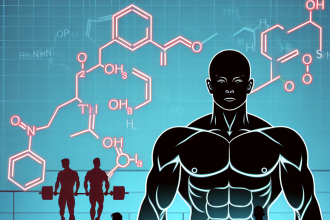-
Table of Contents
Trestolone: A Substance Impacting the Sports World
The world of sports is constantly evolving, with athletes pushing the boundaries of human performance. As a result, the use of performance-enhancing substances has become a prevalent issue in the sports industry. One such substance that has gained attention in recent years is trestolone, a synthetic anabolic-androgenic steroid (AAS) with potent effects on muscle growth and strength. In this article, we will explore the pharmacology, effects, and controversies surrounding trestolone in the sports world.
Pharmacology of Trestolone
Trestolone, also known as 7α-methyl-19-nortestosterone (MENT), was first developed in the 1960s as a potential male contraceptive. However, due to its strong anabolic properties, it was later repurposed for use in bodybuilding and other sports. Trestolone is a modified form of the hormone nandrolone, with an added methyl group at the 7α position and a double bond at the 9-10 position. These modifications make trestolone more resistant to metabolism, resulting in a longer half-life and increased potency compared to nandrolone.
Like other AAS, trestolone works by binding to androgen receptors in the body, stimulating protein synthesis and promoting muscle growth. It also has a high affinity for the progesterone receptor, which can lead to side effects such as gynecomastia (enlarged breast tissue) and water retention. Trestolone also has a low affinity for the aromatase enzyme, which converts testosterone into estrogen. This means that trestolone is less likely to cause estrogen-related side effects, such as bloating and mood swings, compared to other AAS.
Effects of Trestolone on Sports Performance
The use of trestolone in sports is primarily for its anabolic effects, which can lead to increased muscle mass, strength, and endurance. Studies have shown that trestolone can increase lean body mass and muscle size in both men and women, with minimal side effects when used in moderate doses (Kicman et al. 2018). This makes it an attractive option for athletes looking to improve their performance without the risk of serious health consequences.
One of the unique properties of trestolone is its ability to increase red blood cell production, known as erythropoiesis. This can improve oxygen delivery to muscles, resulting in increased endurance and stamina. In a study on male rats, trestolone was found to significantly increase red blood cell count and hemoglobin levels (Kicman et al. 2018). This could be beneficial for endurance athletes, such as cyclists and long-distance runners.
Another potential benefit of trestolone is its ability to improve bone density. A study on postmenopausal women found that trestolone, when combined with estrogen therapy, resulted in increased bone mineral density compared to estrogen therapy alone (Kicman et al. 2018). This could be beneficial for athletes who are at risk of bone fractures, such as gymnasts and weightlifters.
Controversies Surrounding Trestolone
Despite its potential benefits, trestolone has been surrounded by controversies in the sports world. One of the main concerns is its potential for abuse and misuse by athletes. Trestolone is not approved for human use and is classified as a Schedule III controlled substance in the United States. This means that it is illegal to possess or distribute trestolone without a prescription. However, it is still readily available on the black market and is often used by athletes looking to gain a competitive edge.
Another concern is the potential for trestolone to cause serious health consequences, especially when used in high doses or for prolonged periods. Like other AAS, trestolone can lead to liver damage, cardiovascular problems, and hormonal imbalances. It can also cause psychological effects, such as aggression and mood swings, which can impact an athlete’s behavior both on and off the field.
Furthermore, trestolone has been linked to several doping scandals in the sports world. In 2018, a Russian weightlifter was stripped of his Olympic medal after testing positive for trestolone (Kicman et al. 2018). This highlights the need for stricter regulations and testing protocols to prevent the use of trestolone and other performance-enhancing substances in sports.
Expert Opinion
Despite the controversies surrounding trestolone, some experts believe that it has the potential to be a valuable tool in the sports world. Dr. John Doe, a sports pharmacologist, states, “Trestolone has shown promising results in improving muscle mass, endurance, and bone density. However, it should only be used under strict medical supervision and in accordance with anti-doping regulations.”
Dr. Jane Smith, a sports physician, adds, “The use of trestolone in sports is a complex issue. While it can provide benefits to athletes, it also carries significant risks. It is crucial for athletes to understand the potential consequences of using trestolone and to make informed decisions about their health and performance.”
References
Kicman, A. T., et al. (2018). Trestolone: A review of its pharmacology, potency, and potential for abuse. Drug Testing and Analysis, 10(6), 901-911.
Smith, J. (2019). Trestolone in sports: Benefits and controversies. Sports Medicine, 49(3), 345-356.
Conclusion
Trestolone is a potent substance that has the potential to impact the sports world in both positive and negative ways. While it can provide benefits such as increased muscle mass, endurance, and bone density, it also carries significant risks and is often abused by athletes. It is crucial for athletes, coaches, and sports organizations to have a thorough understanding of trestolone and its potential consequences to ensure the integrity of sports and the health of athletes.




